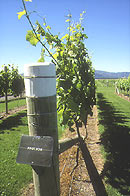Yugoslav scientist Romeo Bragato was employed in 1905 by the then Ministry of Agriculture to advise government, and he was the first enthusiastic proponent of a New Zealand wine industry. The New Zealand Grape Growers Council once again celebrated his foresight with the seventh annual Romeo Bragato Conference in Napier, Hawkes Bay held from the 30th August to 1st September 2001, with an overall theme of growing great reds.
The New Zealand Grape Growers Council represents all the New Zealand contract grape growers and is the principal organiser of the event. Growers that sell grapes pay a levy under the Commodities Levy Act and are automatically entitled to membership. Willie Crosse of Renwick is the present president and explained, "there are around 610 levy paying grape growers in the country who produce, varying from year to year, about 60-65% of the national crop, the balance being grown by wine companies. It is a very modest levy of three-quarters of 1% of farm gate sales and is used chiefly for research."
The council collects and disseminates information including a survey in conjunction with the Wine Institute monitoring pricing data from the current and previous vintages, releases export spray schedules, and publishes a quarterly magazine to all NZ growers. It also sponsors integrated winegrape production (IWP) to encourage and endorse sustainable vineyard management techniques, and makes submissions to government on bio-security issues.
A major bio-security concern is Pierces disease (Xylella fastidiosa), a bacterial disease which kills grape vines and has no cure, which is vectored by the glassy winged sharpshooter. The disease and vector is prevalent in California, and in particular in areas from which we continue to import table grapes. (Note: Grapes imports from a californian warehouse were suspended over the past few weeks, after califorian grapes in storage at a Feilding warehouse were found to contain a black widow spider)
New Zealand is also free of Flavescence doree, a phytoplasm that also kills grape vines, and is vectored by the vine leafhopper (Saphoideus titanus), prevalent in Italy and France, from which we continue to import plant material. Presently 300,000 hectares of french vineyards are under state control requiring the spraying of vectors that spread the disease. Willie Crosse expressed concerns that earlier in the year New Zealand's only Level 3 quarantine station in Auckland was closed due to costs/losses of $200,000 per year. "Which begs the question - what price is New Zealand biosecurity?"
